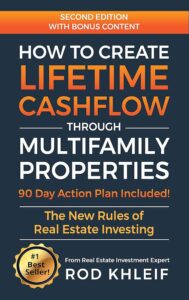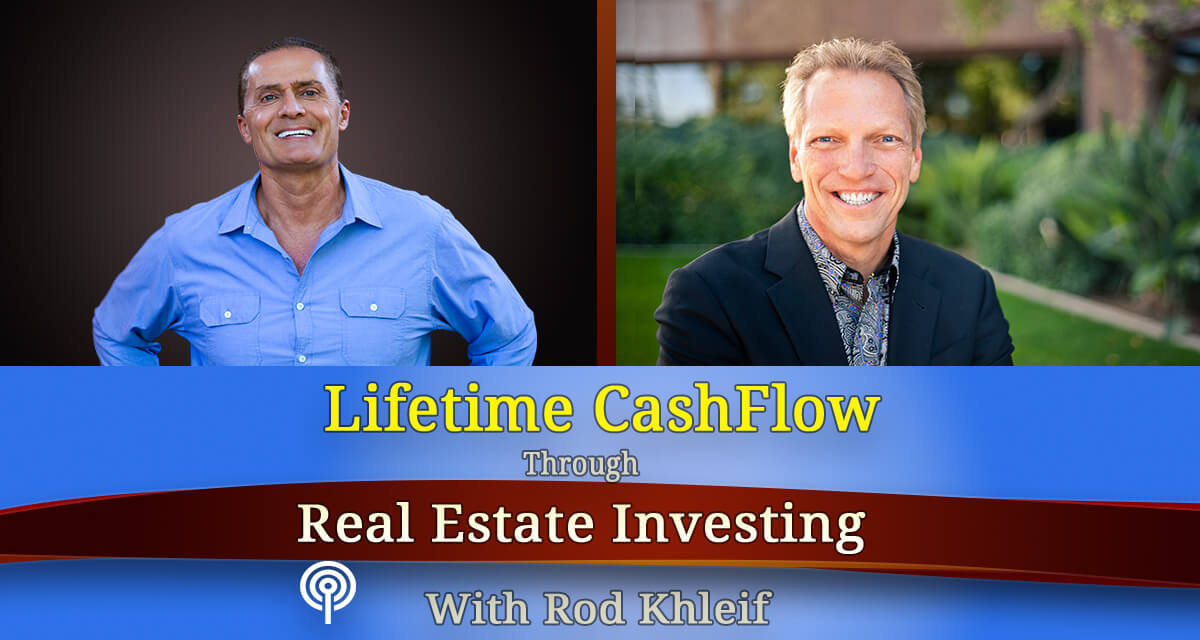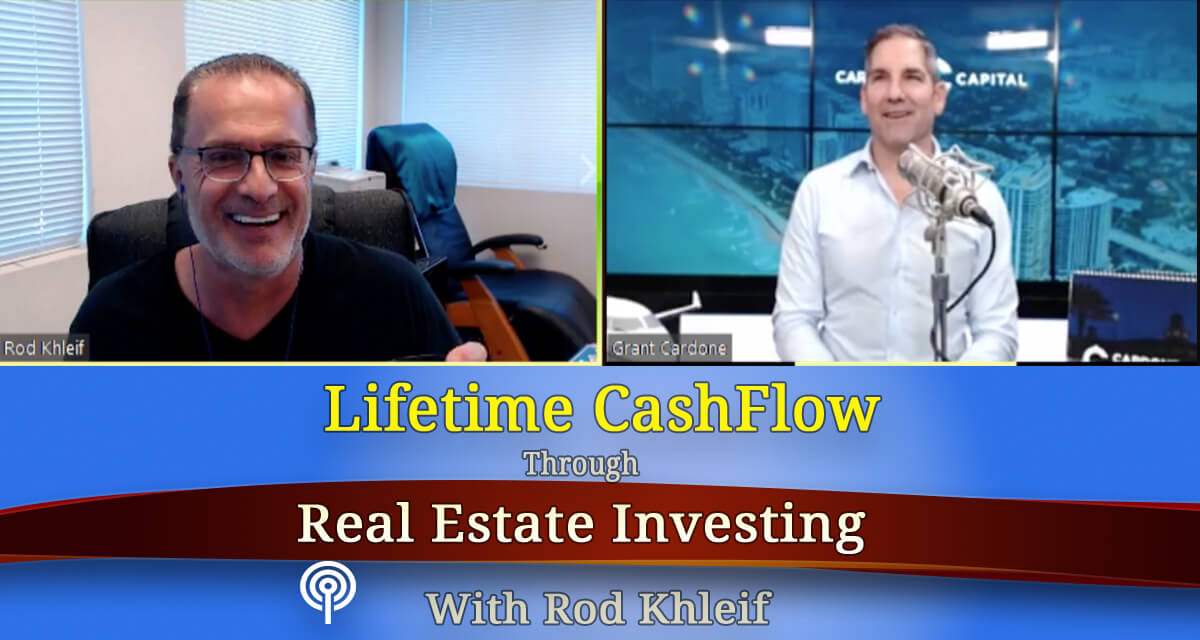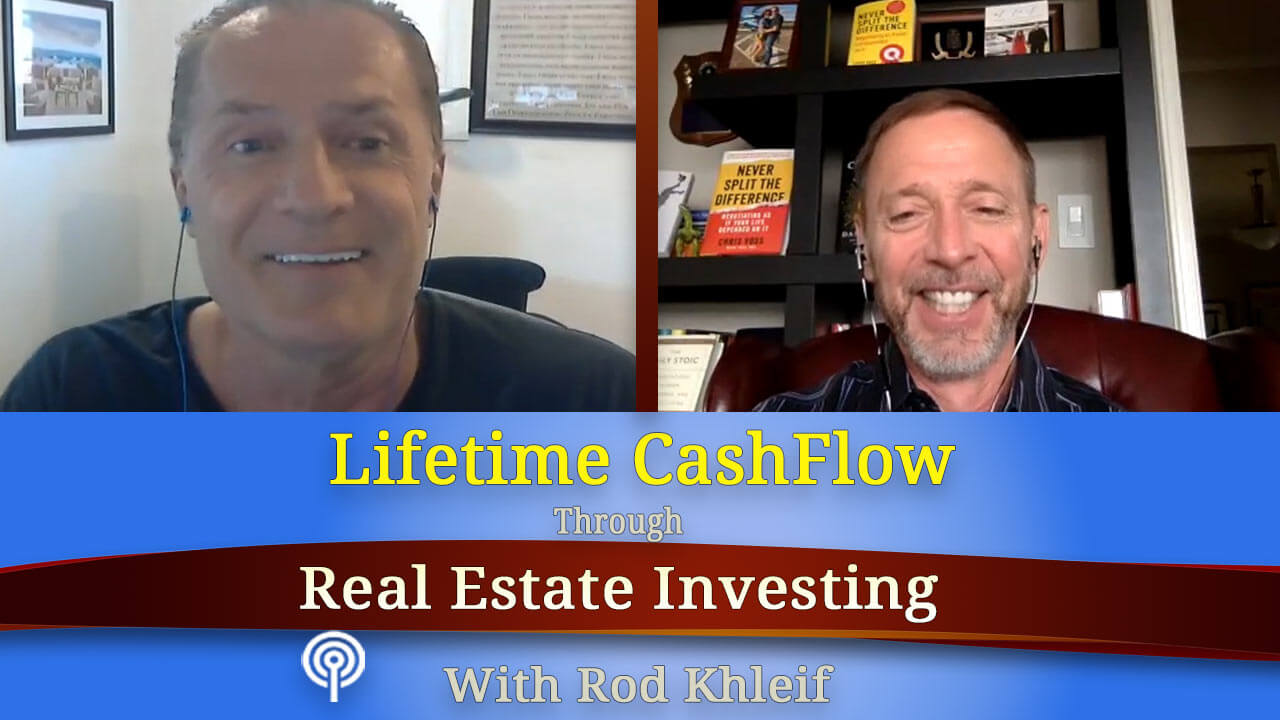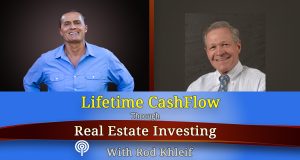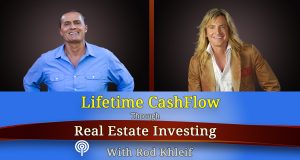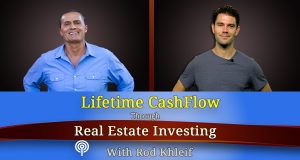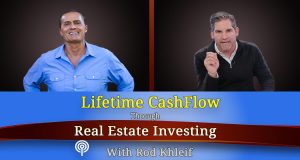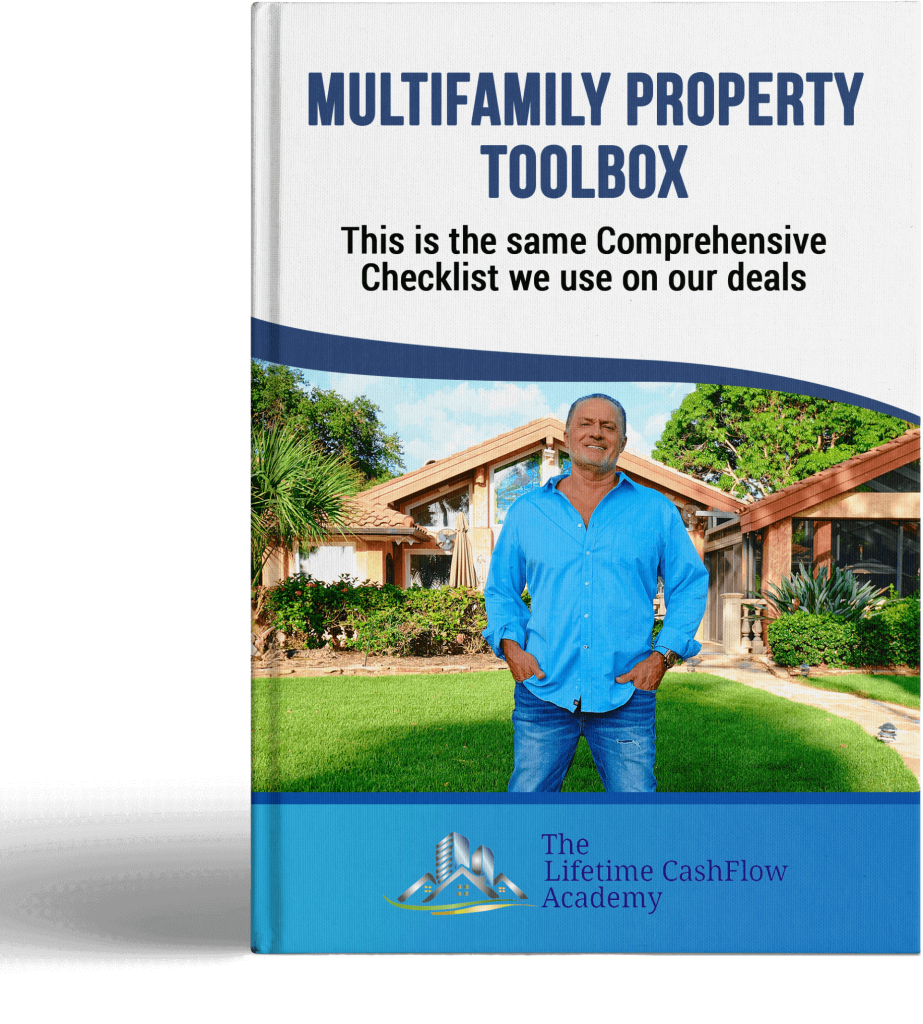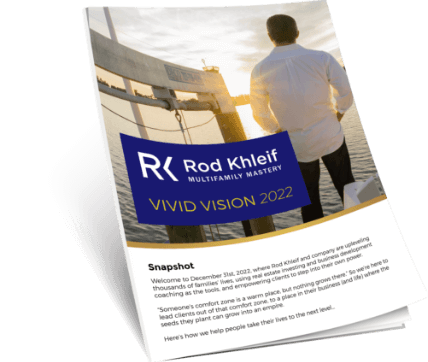Ep #616 – Behind the scenes of a Multifamily Purchase
Scott Holmes is an accomplished acquisitions and asset management leader with more than 25 years of experience and over $6 Billion of closed transactions in all major property types nationwide. Scott and Rod are partners in CreeCapital and in this episode, discuss in detail the behind the scenes takedown of a 297 unit property.
Here’s some of the topics we covered:
- Keeping up with brokers
- Investment criteria
- Agency debt
- Offer ‘rounds’ and ‘final invest’
- LOI to PSA process
- Early access and Due diligence
- Polling your tenants
- Win Win Solutions
- Equity Raise
For more information on our guest, please visit:
https://CreeCapital.com
Full Transcript Below:
Rod: Welcome to another edition of “How To Build a Lifetime Cash Flow Through Real Estate Investing”. I’m Rod Khleif and I’m thrilled that you’re here. And you are going to get tremendous value from the gentleman I’m interviewing today who also happens to be my partner, Scott Holmes. Now Scott and I started working together, I don’t know, maybe six months ago. We just closed on a beautiful asset in San Antonio and I’m not gonna spend any time introducing him because I really want him to give you his background which is incredibly impressive. Scott, welcome to the show buddy.
Scott: Thank you very much!
Rod: Yeah.
Scott: Be a first-time guest on your show.
Rod: Right. Right. Right. You know we’ve talked several times a day so it’s kind of funny to have this formal exchange as we start the interview here. It’s actually a little weird but, you know, why don’t you take a minute and tell my listeners who you are and where you came from and what you’ve accomplished so far in your career which is very impressive.
Scott: Sure. Well, thank you and as you know I’m not a big fan of talking about myself so this puts me on the spot a little bit makes me feel awkward but that’s okay. So, yeah, Scott Holmes is my name. I am a native of San Diego, California of all places. So very spoiled for the weather. I grew up the son of a real estate developer so kind of always had real estate, commercial real estate in the blood. You know, it was just sort of the family business and the shop talk around the kitchen table growing up. You knew that was what I wanted to go into and do in one form or another, not necessarily development but commercial real estate of some kind. So really that’s been my entire career ever since getting out of college. I was a real estate major at San Diego State. Worked for a Japanese company back in you know, the early ‘90s when the Japanese seemed to still own all the really big flagship stuff all around the US. That’s kind of how I first got my start in the big commercial real estate world. Transitioned into working for a company that is known today as Jones Lang LaSalle. They were called LaSalle Partners back then but I worked for them for a little while. Got my MBA at night from Pepperdine while living in Los Angeles after college. And then really transitioned into the investment side of things in the late ‘90s. Started working for a pension fund advisor. The pension fund advisory world for many of your listeners is probably not aware that that’s actually a very large source of capital in the commercial real estate world here in the US. Pension funds own quite a lot of commercial real estate as part of their retirement plans for their retirees. So that was a new aspect of the business for me that I really enjoyed working in. Got into acquisitions there so I was in charge of a team nationwide buying, you know, all four of the major product types: office buildings, industrial multifamily, and retail shopping centers. And, you know, like most asset allocators pension funds like to diversify their portfolios by location and by asset, asset class, or property type. And so I had a lot of good opportunities to build and grow a team and build a network all over the country. You know, doing deals really all over the place. I think as I look back over the deals I’ve closed it’s more than 40 states that I’ve had an opportunity to close deals in. So that’s what really got me into the bigger institutional side of things was working for a pension fund advisor transitioned to working for another one for several years. Ultimately got recruited by a REIT that’s based here in Arizona where I live now. I live in Scottsdale. And so I came out here to take over an acquisitions team primarily buying shopping centers as well as some office and industrial. Really all over the country and we were one of the biggest acquirers of commercial real estate in the early 2010’s. Coming out of the great financial crisis that was obviously a great time to have capital and to buy deals. So we did a lot of really solid deals, grew that company, and took it public. And then after all that, went over to what I affectionately refer to as the dark side. I got recruited by a brokerage company called Marcus & Millichap. And I’m sure many of your listeners are familiar with that company. They have probably more agents than just about any other all over North America. And so I wasn’t a broker working for them but I was part of the senior management team overseeing one of their larger divisions namely the retail and net lease divisions of that company. So had about 450 or so agents all over North America that were part of that group and gave leadership and direction to that and really just enjoyed, you know, the role as more of a coach. You know, more of someone who could help you know those people understand what their clients are looking for because I had been a client for you know 20 plus years of brokers like that. So I could help them understand how to add value to their clients and how to upgrade their business and all that. So I really enjoyed doing that for about three years but missed the active investing side of things and really wanted to get back into doing that. So I started reaching out and networking and trying to figure out, you know, hey, how could I do this more on my own? Not really on my own because real estate is a team sport as I’m sure we’ll talk about. But, you know, how could I do this not under a big institutional umbrella? You know, I don’t really want to be on the, you know, this side of things forever. How could I get back into doing, you know, principal investing again and after reaching out to a lot of different people and meeting several others, we reached out to you and we started that conversation at the beginning of this year and it took a couple of months for us to, you know, sort of feel each other out and see if this was going to work or not. And once we finally pulled the trigger, it was off to the races.
Rod: Yeah.
Scott: And we’ve got our first closed deal already which is great so–
Rod: Yeah. Yeah.
Scott: And that’s kind of the short version of my roads.
Rod: That’s a great background and I don’t know if you said the number but, you know, you’ve closed over six billion in assets which is–
Scott: No, I didn’t. Yeah, I’ll let you say that.
Rod: Yeah. Yeah. Six billion is a pretty big number. And so–
Scott: Yeah.
Rod: In acquisitions. So, yeah, and that’s one of the things I love about you Scott is, you know, you’re humble and it’s not about being braggadocious and I try to catch myself as often as I can in that regard as well. But yeah, so, you know, we– and, you know, what’s interesting guys is, we formed a partnership obviously and many of you heard me talk about how important it is to be careful when you start a partnership and I’ve got a free resource that’s got all the questions you should ask when you’re forming a partnership which we went through. And so, you know, it’s not a do as I say, you know, not as I do kind of a thing. And so, yeah, and what I’m thinking might be fun to talk about today. We just last night, you know, we closed on this deal in San Antonio, 296 units. Absolutely a screaming deal. And we had, you know, one of the things that we do for our investors is we do educational. We give, we educate them
kind of behind the curtain, you know, on the little nuances we went through on this particular deal because there’s only so much I can teach from the stage. And by the way guys, my Orlando boot camp is coming up here and I’m only going to do one live event a year moving forward. And that’s the first time I’ve announced that, by the way. Nobody knows that so you’re hearing it for the first time here. I’m only going to do one live event and this one is going to be in Orlando. December 3rd, 4th, and 5th and I sure hope you can make it because it’ll, you know, it’s going to be a big one and people rave about these events. But anyway, I digress. So, you know, I thought that maybe what we could do Scott because it’s fresh on the mind is maybe talk about some of the things we talked about last night with our investors that are in that deal. And talk about this deal and kind of give you guys a little bit of the behind the scenes which we don’t usually do on this show in a deal. So, you know, if you want to take it away Scott, talk about how we found the deal. Let’s start there and work our way through the due diligence, through the financing, through the rise of the equity, you know, all the way through to where we are right now. So why don’t you start and I’ll just chime in as needed.
Scott: Sure. Yeah. Well, you know, obviously with my background in acquisitions and I’m on a bunch of brokers lists already, you know, with the criteria and the things we’re looking for I obviously, once you and I formed our partnership went and updated that at all the major brokerage houses and with their various systems and made sure they knew what it was we were looking for. So we, you know, you have to kiss a lot of frogs as I think you say often. You know, we looked at a lot of different deals and rejected a lot of them as not quite fitting exactly what we were looking for and maybe I should start with that. You know, what were the criteria we were looking for? You know, something in the call it, you know, 15 to 40 million dollar price range. We want to sort of being above the small private guys but below the big institutional guys. And so that’s kind of the window ideally that we were targeting. Locationally, we were looking at the Southern States primarily because those are the higher growth areas, the lower regulation areas, you’ve got good job growth, population growth, income growth happening in those areas. So Texas certainly was a prime target for us. All four of the major metro areas around Texas were on our list. We were looking at a lot of different deals in them. We were looking for something that was, you know, class B, you know, maybe B minus even. But not, we didn’t want to go all the way down into class C and D stuff. We wanted something that was relatively stable. You know, price competitive versus the new, nice, luxury stuff being built in the area. But we also were concerned for the area. We wanted the area to be, you know, an improving area and not a declining area. And so, all of those things were important to us and when this deal which is called Sedona Canyon came across our desks, you know, we looked at it and said hey this looks like it’s kind of hitting on about nine out of ten factors here. Let’s dig in deeper. Let’s do some underwriting. Some of the initial concerns we had about the deal were very quickly answered very favorably at my dad.
Rod: Right.
Scott: And so we got excited about it and started to pursue it even more. We also have a local partner there in San Antonio.
Rod: A warrior.
Scott: Gave us an advantage. Yup. One of the warrior group folks. And so that allowed us to leverage, you know, somebody locally there to go take a look at things and meet with people, you know, to send us pictures to, you know, help us really fine-tune our underwriting. So while that was going on that end, I was also having conversations with the investment sale broker, with the person at their loan broker side of the company as well because we wanted to, you know, to obviously do financing on this. It was very clear that this was going to be a good candidate for agency debt because it had a really good solid, you know, above 90% occupancy for a long time even through Covid and all of that. So, again, that made us comfortable that the downside on this thing was pretty well covered.
Rod: Let me interject one second here. So guys, with agency debt, if you haven’t been through my boot camp, you need to be 90% physically occupied for the previous 90 days. And so it’s something you want to be very careful of. Now, this deal I think we went under contract was at 94% occupied, it’s 96 now and we’ll talk about that a little more as well. But, you know, if you’re right at 90, you need to be careful because if it dips below 90, they’ll knock out your agency debt or they can. So just be very cognizant of that. It’s called 90 for 90. So, yeah. So please continue.
Scott: Yeah. So, you know, there’s no asking price on the deal which is often the case on these, you know, competitively bid assets especially in markets like, you know, the Texas markets right now where sellers know generally speaking. It’s a seller’s market right now and things are improving, you know. The seller, incidentally, I won’t mention them by name but they were a large owner, a Canadian owner that happens to be a big owner here in Phoenix where I live. So I was well aware of who that was, you know, wanted to ask that question. Why are they selling? You know, is there something wrong with this property? Is there something that we need to be aware of? That sort of thing. But no, they’re a big owner here in the Phoenix market. They had tried to expand a few years back into the Texas markets but didn’t have as much success building a large portfolio there. So made a strategic decision to just exit Texas and redeploy that capital here in the Phoenix market which is also a very hot market right now and they’re doing well in. So, you know, getting all that kind of initial stuff out of the way. Building rapport with the broker, building rapport with the loan broker as well. You know, using all of those things to give us good data, good intel on what it was going to take ultimately to, you know, craft an offer that would get accepted. It was a multiple rounds kind of a situation as is often the case. You know, you send in a first-round offer, you get some feedback about how that compares. Yeah. And then they call for you know, a second-round or a final invest. They call it sometimes and, you know, we were able to address the issues of concern, obviously. Things that sellers care about in today’s market is they want to know that they’re going to have certainty of close. They want to know that they’re getting a good price. You know, we didn’t overbid it but neither did we want to lose it by, you know, a hundred thousand dollars on a deal of this size. So, you know, we could see that the market and the performance at this property were steadily improving month over month as we were following this prior to finally getting it under contract. So we knew that, you know, we didn’t want to miss it by a little bit, obviously.
Rod: Right.
Scott: So, you know, there were some issues of physical nature. This is early-mid‘80s.
Rod: Hold on. Hold on. Hold on. Hold on. Let’s talk about the LOI to PSA process because you know, in this hot market guys, you know, back in a normal market, you have a 30-day due diligence period. That’s the normal, okay? But in this hot market, a lot of sellers are requesting money to go hard immediately which can be very dangerous. But, you know, there is a strategy that we utilize and a lot of operators do candidly at this point is they say that the money will go hard upon the execution of the PSA, the Purchase and Sale Agreement. So you put that in the Letter Of Intent, the LOI, but then typically you’re going to have at least a week, if not, two weeks of negotiation time between their attorneys and our attorneys or your attorneys negotiating the nuances, the Purchase and Sale Agreement. And so what you do in the Letter Of Intent is you ask for an early access agreement and where you have access to the property to perform your due diligence. So do you want us to– well I’ll speak to it. So–
Scott: Sure.
Scott: Well, yeah. What we did was, you know, we brought in an awesome property management company. They brought four teams and we viewed, we literally went there for two days and walked every single unit. I mean, there may have been five. We didn’t get in out of 296 because of Covid or whatever. But literally, every unit and, you know, they were very tech-driven so they were using iPads and iPhones to log, you know, the condition of the units. They’re, you know, taking pictures inside of those as well that all went into
a system that they use which was an awesome system, to tell us exactly what the condition was of each unit. You know, of all the appliances, the HVAC, all that stuff. And then, so we can carefully assess the CapEx that’s needed and this system rated each item so that, you know, they’d look at the countertop and they’d rate it on a scale of one to five, you know, five being the best. And so we would get an idea of what needs to be replaced, what’s okay and so on and so forth as part of that due diligence process. Of course, we had vendors out there. We were concerned that the roof might, the roof is a little dirty and we thought that it might, you know, need to be replaced before too long and we’ve even budgeted half a million dollars for that in our CapEx but once the roofer got up on the roof which of course we had to wait till we were, you know, under contract to do that. You can’t send vendors out to get actual bids on stuff until you’re, you know, you’ve got the deal locked. And so, you know, they told us we’ve got five to possibly, actually, really seven or eight years left on that roof. And so, you know, that was a win. Then we also– We had the line scoped, you know, a certain percentage of the sewer lines you want to do that because there were some big trees there. And then the last thing I’ll mention is, you know, well, why don’t you speak to the engineering situation? Why don’t you speak to that?
Scott: Sure. Sure. Yeah, so you know, part of the reason we got selected was, as Rod was mentioning, we, you know, are not only the price being competitive but our terms were very competitive. You know, we were able to put up a significant earnest money deposit and have that be “non-refundable” at the signing of the contract. Obviously, you build into your contract a few, you know, a few outs here and there. But, you know, those intervening couple of weeks while we were finalizing the contract, is when they gave us early access to do all this due diligence. Well, one of the things we found, you know, one of the vendors we had out there, a contractor, general contractor, pointed out some areas of concern on one of the buildings where it looked like there was maybe some bowing on one of the walls. Maybe some settling and so there was concern that there might be a structural element, you know, that needed further study. And sure enough, you know, when we went and looked at it and kind of lean up against the wall and look straight up this brick wall you could see kind of an unsettling, you know, bend in the wall which kind of freaks you out a little bit when–
Rod: Let me add something. Let me add something
guys. And so, you know, there’s a real lesson in all this. Okay. I mean, I have looked at thousand, and so Scott, thousands and thousands of buildings, and we both would have missed this. Okay. And so, but we had a general contractor out there. You know, you should have that or a building inspector. Somebody that’s super competent, walk this property with you because they will see things you don’t. So there’s a perfect example of that. You had to stand just right to see this brick wall that was kind of bowing at the top and it would have been really easy to miss. But, you know, as a result of that, you know, we’re gonna have to– luckily, the wall is not load-bearing. It’s just an aesthetic, you know, touch to that building. And so we’re going to replace the wall obviously, but it’s not a big deal as it would be if it were load-bearing. And so, you know, what we did or what Scott did very very well was because this was an issue obviously, we told the seller, hey, we need a little more time to get an engineer out here and do an engineer’s report. And so we found a local engineer and they were able to research all the records to see that yeah, there has been a little pinning done. I mean, it’s a 40-year old complex. You’re going to have some settling especially a big, big complex like this and there’s plenty of rain there and stuff but they had done some shoring up. And again, there’s no evidence of cracking other
than that one brick wall. The rest of the structure, there was no evidence of any significant issue at all. No, you know, floors blowing up and things that you see if there’s a problem like that. But we got an engineer out there and what that did was, that also gave us extra due diligence time. Okay. And so because we could have backed out over the engineer’s report. So I gave us a little extra breathing window which was really kind of nice. But, and then we were able to, you know, I’m not gonna, let’s not talk numbers but we were able to get a decent concession from the seller to fix that brick wall and do some drainage. Yeah, do some other drainage issues that at some point if they weren’t corrected would be a problem and so we’re going to proactively make sure there’s no problem. So, anyway, I just wanted to talk about the PSA there for a minute. You know, let’s talk a little bit more about the
due diligence. Oh yeah, and there was some, we might have to do a couple of retaining walls that from the rain, need to come down. But, you know, one of the things that we’re doing there, you know, we’ve got a lot of CapEx we’re doing. A lot of exciting things that are gonna, you know, make this deal, you know, this already a screaming deal. I’ll explain why in a minute but what was going to make it even better. But what we decided rather than bringing in contractors to do that, we’re going to hire a couple of extra maintenance guys to help with this stuff because a lot of it’s like, you know, some wood rot and trim you know wood rot on some of the patios, things like that, that a maintenance guy can repair. And so we’re gonna do it that way. I’ll just briefly mention some of these other things on our list. So some of the value add things that we’re doing there is we’re going to resurface stripe and put numbers on all the parking spaces because, you know, there are some areas of the parking lot that are very desirable for people to park and we’re going to allow people to rent those numbered spaces and reserve them which is one of the CapEx. I mean, sorry, one of the value-add things we’re going to do, which is really going to be a home run. We already know that.
Scott: That’s something that’s already happening at other competitive properties so we know it’s doable. It’s not some brand new novel thing that we’re going to be introducing to the market.
Rod: Right. You know, and all the units there have laundry, laundry hookups but not all of them have washers, dryers. Some of these people, you know, haven’t spent the money to buy a washer and dryer. And so we’re going to offer those for rent. You know, we’re also implementing– we’re gonna assess the desire for a couple of these things as well. There’s an opportunity there at the back of that complex for self-storage. And so we’re evaluating that right now. The city will allow us to do it. There’s a great area for it and so we’re gonna– we think there’s gonna be a big demand for it as well with these units. And so, that’s something we don’t even have in our pro forma.
Scott: Yeah. We didn’t even underwrite that.
Rod: But yeah, that’s just going to be a bonus. Yeah. But, you know, and then, you know, I said, did I say tech package? We’re going to ask them if they want a tech package. So we’re sending a survey to all the residents just to give you guys an idea. So we were there last week with the property management company onboarding them and they’re very, very impressive but we’re gonna send a survey with an announcement of some of the things we’re gonna do there like the parking lot. We’re dressing up the pool with some more colors and some coverings and things like that. We’re dressing up the exercise room. We’re putting in a camera system in the whole complex for security. We’re moving the dog park because it’s out in the middle of the sun and it’s just useless where it’s at and it needs to have shade. So we’re going to move it to an area that has shade. But, so we’re going to announce all these things and then as part of that, we’re going to give each resident 10 bucks off the rent if they answer the survey questions. And so, you know, that might be a little excessive but it’ll cost us, you know, maybe three grand if everybody responds. But I think it’ll be three grand, extremely well spent because we’ll find out what they want. We’re going to ask them what they like about the place. What they’d like fixed. What they’d like to see and then ask them about these other things like the storage, like the parking. We’re also going to put in covered parking. There are a couple of areas where we can put in covered parking. So, you know, we’ll be able to ask them what they feel about that. And so we’re excited to get that rolling out. Anyway, you want to talk about the financing maybe for a minute?
Scott: Yeah. You know, before we get off that subject, I will get that in just a second. You reminded me of something though. You know, during the due diligence process, you know, with that structural thing too just, you know, I think this is probably a benefit to your listeners. You know, doing due diligence is not about knowing everything and having all the answers yourself. It’s about knowing who to call and what experts to bring in and how to marshal those resources quickly and effectively. And so, you know, on that second day of our due diligence trip on-site was when we discovered this and we immediately went back to the management office, sat down, pulled open the laptop, and started calling structural engineers in San Antonio. And I think it was the second or third one we called and said oh, yeah I know that. I know that property, you know, let me pull it up on the website. They actually had some records. They had done some previous work, nothing major and they were quickly able to help us understand that alright this is probably not that big of a deal.
Rod: Right.
Scott: And they were able to tell us, you know, the earliest we could get out there is unfortunately two weeks later. You know, they’re like all contractors, they’ve got a backlog of things they’re working on. And so my next call was to the broker to say, hey, you know, you need to come out here. I need to show you something of significance and we need to talk about how to, you know, come up with a women’s solution here. So he came out, we showed it to him, we talked to him about the structural engineer, and the fact that their timing was going to require us to have, you know, at least two to three more weeks on the due diligence for that. And so, you know, I was able to say right then that, you know, we can still sign our contract and be non-refundable with respect to all the due diligence we’re doing right now. However, we need an extra time period for this one element. So we were able to craft a very easy amendment to the Purchase and Sale Agreement that carved out this one structural engineer inspection but leave it broad enough that we could, you know, basically have an out for another three weeks. And that gave us some breathing room to really, you know, get all the rest of everything done that we needed to do. So, you know, finding the right people, getting them scheduled, you know, taking quick action and all that helps your credibility obviously, with your seller, your broker, but it also helps you, you know, craft a solution that’s going to work out ultimately for you and that’s what we did in that case. And then, when we finally got the report back, you know, it was good news. Hey, it’s not something that’s going to take down a whole building. You’re not going to, you know, my concern whenever you see an element like that is hey, does this make some of my units unrentable and that’s where the real value hit, would be, if you can’t rent out certain units while you’re having to repair something. You know, lost income is a big value. But again, in this case, not an issue. We got a concession from the seller to deal with it. It’s a cosmetic thing. It’s not going to take any units down. We got that comfort level. We’ve got a report now from a structural engineer that covers us. So we feel great about that. But again, it’s not about having all the answers yourself, it’s about, you know, marshaling those resources quickly and finding the right people. And we did, thankfully. We’re able to do that, you know, within an hour or two of seeing it. So anyway, final thing–
Rod: So just real briefly on the financing, you know, just how we looked at this. You know, how we pushed our partners on the deal and so on and so forth real quick.
Scott: Sure. So that, you know, as I said at the beginning, we recognized that this would be a good candidate for agency debt. So meaning, Fannie Mae and Freddie Mac. We worked with a broker to, you know, to shop this out and get quotes from multiple different sources that obviously looked to us like the best terms that we were going to get. You know, 70 to 75% loan to value is about all you can expect from the agencies. So it’s a little more conservative in that regard. But so are we. We want to be conservative in our underwriting and our ability to, you know, to make the asset perform. So that’s how we underwrote the deal, was to go that route. You know, working with a new company and a new set of general partners, new, you know, key principles that we’re going to be signing on. That meant that we had a lot of hoops to jump through and a lot of, you know, underwriting questions from the lender to answer. We chose to go down the route of qualifying for the Freddie Mac terms because those are a little more difficult and a little harder. So that even if, at the end of the day, we decided that the Fannie Mae, you know, option was better. We would have already qualified for both. They wouldn’t have to jump through any additional hoops, you know, to switch over to Freddie Mac. At the end of the day, the Fannie didn’t have better terms for us, so we were able to get a 70% loan to value. We locked in a great rate at 3.30 right at a dip. You know, we were tracking the 10-year treasury. The way they quote those is as a spread over the 10-year treasury so we had about a 2% spread on top of where the 10-year treasury was. You know, if you look where that is today, I’m looking at my watch, yes. The 10-year treasury is about 150 today. It had dropped to 128 at the time that we put in that lock so we were able to get a 3.3% loan fixed.
Rod: Let me explain why that’s such a big deal. So, if we had locked that loan today, they would have reduced our loan by over half a million dollars, okay? And it’s called the loan proceeds. And so, you know, Scott monitors that 10-year treasury on a day-by-day, hour-by-hour basis because you can start to see trends. Yeah, it’s on his watch. You can’t see. He’s got it on his watch. He’s a real nerd. So he’s got it on his watch. But, you know, that’s how we were able to lock in this fantastic rate and that’s locked for ten years. Okay. I mean, I remember when 7% was a freaking screaming interest rate and we locked this thing at 3.3. It’s just incredible. But, alright, well let’s–
Scott: The other good part too, is the first five years are interest-only so that was the other reason we went with Fannie Mae is that we were able to get five years of interest only. Some of the other options were only three years of interest only.
Rod: Right.
Scott: So that means you don’t have to pay principal during that time which gives you more capital to work with, you know, during the time we’re doing our value add strategy so obviously, that all of that is a benefit to us and our investors.
Rod: Yeah and that’s– you can’t get that on every deal. It’s got to be a pretty solid deal for them to consider five years of interest only. Sometimes, you’ll see a year, two years, three years, five years is a big deal. And of course, that greatly enhances returns. And, you know, we’re at, you know, super conservatively 10% cash, probably 10-12% cash on cash. 15% to 17% IRR. I think once it’s all said and done and, you know, and we try to under promise and over deliver. But, you know, let’s talk about the equity rate. So here’s the deal. Now, Scott and I have been– Scott’s son got married, daughter went to school, college, and we had two live events. And so I had the live events and all kinds of things on my end as well. So we haven’t been that diligent on raising the money. And so, I think we have commitments for like 14, almost 14 and a half million. We only need 12, six. Now, I will tell you guys. Listen up here. When you’re raising money for a deal, it’s super important that you get overcommitted because just for this very reason, now we’re going to start making outbound calls and wrapping the rest of this up. But let me say this. If you’re accredited, there are still some slots left in this thing and you can get in it. I think it will probably be wrapped up in about three weeks maybe four weeks but if you’re interested, text “PARTNER” to “72345” and you can get on our calendars for a call or you can go directly to “creecap.com”
and there was a full-blown presentation we did on this asset for an hour that you can watch. And then you can also schedule a call or you can just register on the portal. But you do have to be accredited. Okay? And, you know, if you haven’t heard me talk about this deal, you know, this is really unusually good and unusually conservative and the fact that like right now we closed on it last week. We can break even today at about, what is it, 58%,59%, economically occupied. So, 41%,42% vacant. Okay. Economically vacant. Which is just–
Scott: And it’s never been that.
Rod: Yeah. And well of course, no it’s 96% occupied now. So it’s never been that but the point is that’s how conservative the deal is which is very unusual. And the other thing you’re gonna find is, you know, many operators will offer a preferred return and then they’ll do a split on the back end and that’s what we do. We offer an 8% preferred return and then a 50/50 split. And you will see operators that offer, you know, a preferred return plus say an 80/20 split or a 70/30 split in favor of the investor. But here’s the thing, they have to do that because the deal is tighter.
And so this deal is not at all. And we do ours at 50/50 anyway. But the point is we don’t have to, you know, raise the back end split because this deal is that solid and that exciting. And, you know, I will tell you, you know, we just got a report recently that the rents in San Antonio in the last 12 months went up 18%. Okay. Now just think about that for a minute. 18% which is just staggering. So anyway, if you are interested like let me mention that just I didn’t think about that but there are some slots left and you can absolutely get in. So again, text “PARTNER” to “72345” to talk to us or you can go to “creecap.com” and watch the presentation, get on our calendars, register all of that stuff. If you’re accredited. If you’re accredited.
Scott: Yeah. And we did not underwrite an 18% rent increase in our model by the way.
Rod: We did not, at all.
Scott: We had 6% for two years and then 3% thereafter and that’s because we’re going to be doing a lot of improvements, rehab to the units, things of that nature. But what’s interesting is they’re already getting organically in the market right now. Rent increases, you know, that are at or above that level so that’s why we feel so excited about this deal.
Rod: Yeah let me say one other thing that’s super unusual in this deal. So once we got it under contract or rather once our money went hard and they knew we weren’t going to walk away from 600,000 in earnest money. They cut the office down to one person. Okay. So, you know, usually there’s three and a big maintenance staff they have. I think one person, one maintenance guy and, you know, and that’s a little frustrating. But what’s crazy about it is that the property improved through the entire under-contract process, so much to the point that it impacted our loan proceeds positively. Which is again, very unusual. So, you know, a very exciting deal and a really awesome first deal for us to do together, Scott and I. I’m really really glad that we got it. But, yeah.
Scott: After we closed the seller even told us that they regretted selling it too soon because the market has been improving so much so–
Rod: The seller’s remorse. Yeah, sellers remorse on that thing. So anyway, yeah if you– and even you know, even if you’re not accredited, if you want to go to that portal and just watch the presentation, you’ll see how we present a deal which should be really informative. So you can see why we love San Antonio, why we love that sub-market, why we love that deal. You know, how conservative, really super conservative our underwriting is. You know, high vacancy, the first couple of three years because we’re going to, you know, be improving units. What those improvements are going to be and so on and so forth. You just get a really good understanding of how we present a deal if nothing else but, so you’re welcome to do that but you can’t invest unless you’re accredited. You know, if you come to my boot camp you’ll understand, you know, why you can’t do that and the different types of syndication. All that because all the syndication attorneys there. But anyway, any last-minute thoughts here? We ran a pretty good time there.
Scott: I know. I’m excited about it as you are and hopefully people can get a sense of that. You know, I generally try to keep a pretty muted, calm attitude about things. You know, I don’t want to get too emotionally attached or invested in things and stay above the fray but this is definitely one of those deals that gets you pretty excited that we’re going to be able to do pretty well on it.
Rod: Yeah. Yeah. No, I agree. I agree. Well, we’re off to, you know, we’re obviously looking for other deals already and we’re looking at bringing in other team members to scale this thing and so very exciting times for us and that side of what we’re doing. But Scott, also helps on, you know, in the warrior program with training and we just had a warrior-only event for our warriors here in Sarasota and we had, I don’t know, about 130 or so, warriors of 130 of our literally a thousand warriors there and we did deep dive on deal analysis. And so Scott presented that, and we had an attorney speak there,
and it was just a blast. But, and by the way, if you’re ever interested in the warrior program text the word “CRUSH” to “72345” and you can chat with us about it but I’m very proud of my warriors. They’re now approaching 46,000 units owned and–
Scott: Wow.
Rod: I’ve been teaching for less than four years. So I’m super proud of that. But Scott, it’s good to see you, buddy. I appreciate you coming to the show. And guys, go make it happen and we’ll talk soon. See you later.




